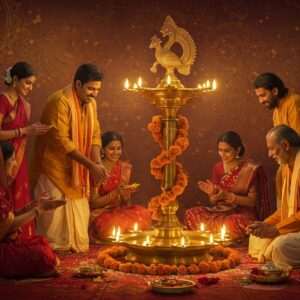
Let’s delve into the heart of Holi, the vibrant “Festival of Colors,” a celebration deeply woven into the fabric of Indian culture. More than just a splash of hues, Holi signifies the arrival of spring, the triumph of good over evil, and the blossoming of love. It’s a time when communities unite, setting aside differences to revel in the shared joy of colors and camaraderie.
The Significance of Holi
Holi is a vibrant tapestry of symbolism, with each thread representing a different aspect of this joyous festival. The victory of good over evil takes center stage, epitomized by the legend of Prahlad and Holika. Prahlad’s unwavering devotion to Lord Vishnu shielded him from harm, while Holika, the embodiment of evil, met her demise in the flames. This narrative serves as a powerful reminder of the ultimate triumph of righteousness and faith.
Holi also celebrates the divine love of Radha and Krishna, infusing the festival with an aura of romance and devotion. The playful exchanges of color are often seen as a reflection of their divine love story.
As winter gives way to spring, Holi marks a time of renewal and hope. The earth awakens with fresh life, symbolizing new beginnings and the promise of a bountiful harvest.
This spirit of renewal extends to human relationships as well. Holi encourages us to let go of past grievances, mend broken bonds, and embrace the opportunity for fresh starts. It fosters harmony and strengthens the sense of community.
Traditions that Paint the Canvas of Holi
Holika Dahan, held on the eve of Holi, is a powerful ritual that symbolizes the burning of evil. Families and communities gather around bonfires, offering prayers and symbolic items like grains and leaves to the flames. The crackling fire represents the purification of negativity and the triumph of light over darkness.
Explore Flammables for Holika Dahan
Rangwali Holi, the main day of the festival, is an explosion of color. Friends and family playfully drench each other with gulal (colored powders) and water, creating a vibrant spectacle of unity and joy. Each color carries its own significance: red for love and fertility, yellow for prosperity and new beginnings, blue representing Krishna, and green symbolizing new life and the arrival of spring. The air fills with laughter and music, as the rhythmic beats of dhols (drums) add to the festive atmosphere.
Find Authentic Gulal and Colors at Poojn.in
The sweetness of gujiya, a traditional dumpling, and the refreshing coolness of thandai, a spiced milk drink, add a delightful culinary dimension to the festivities. Sharing these treats with loved ones strengthens the bonds of kinship and community.
Discover Traditional Holi Treats at Poojn.in
Regional Flavors of Holi
Across India, Holi takes on unique regional hues, showcasing the country’s rich cultural diversity. Lathmar Holi, celebrated in Barsana and Nandgaon, involves women playfully hitting men with sticks, a tradition rooted in local folklore. Dhol Jatra in West Bengal and Odisha features processions filled with the rhythmic energy of drums and devotional songs. Manjal Kuli in Kerala involves the use of turmeric-infused water, adding a unique twist to the celebrations. These regional variations highlight the adaptability and richness of Holi’s traditions.
Explore Regional Holi Celebrations
FAQs about Holi
What’s the real meaning behind Holi? Holi’s essence lies in the victory of good over evil, the embrace of spring, and the joy of renewed relationships. It’s a time for forgiveness, letting go, and starting anew. Delve deeper into the significance of Holi.
Why do we celebrate Holika Dahan? Holika Dahan is a powerful ritual symbolizing the destruction of evil, commemorating Prahlad’s unwavering devotion and Holika’s downfall. The bonfire is seen as a purifying force. Learn more about Holika Dahan rituals and supplies.
What makes Rangwali Holi so special? Rangwali Holi is the exuberant expression of joy and unity through colors. The playful exchange of gulal and water transcends social barriers, fostering a sense of togetherness. Plan your Rangwali Holi celebrations with our guide.
What are the traditional foods we enjoy during Holi? Holi is a feast for the senses, with traditional sweets like gujiya and malpua taking center stage. Thandai, a refreshing spiced milk drink, adds to the festive cheer. Savory dishes like dahi bhalla and papri chaat are also popular choices.Find all your Holi food essentials at Poojn.in.
Celebrating Holi with Poojn.in
At Poojn.in, we understand the importance of celebrating Holi with authenticity and reverence. Our curated collection provides everything you need to observe the traditions with both traditional values and modern convenience. We offer pure, herbal gulal, puja samagri, and a range of festival items like clothing, thalis and utensils.Browse our collection of Holy Utensils
Explore our selection of Holy Clothing.
Shop with us online at www.poojn.in or connect with us via phone at 03369029784 or WhatsApp at 9476142738. Our pan-India delivery ensures that you receive your items securely and with the respect they deserve.
Embrace the Spirit of Holi
Holi is more than just a festival; it’s an embodiment of unity, renewal, and the triumph of good. It’s a time to connect with our cultural heritage, cherish our loved ones, and embrace the vibrant colors of life. As we partake in the timeless rituals and traditions, we honor the past and look forward to a future filled with hope and togetherness. Let the spirit of Holi fill your hearts with joy, love, and the promise of new beginnings.


